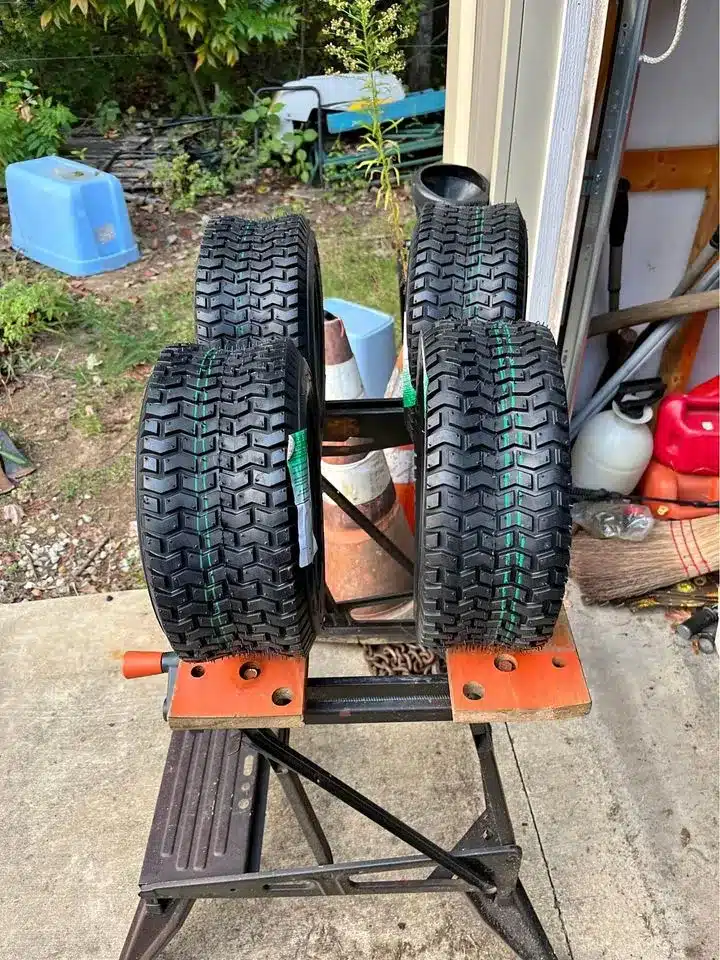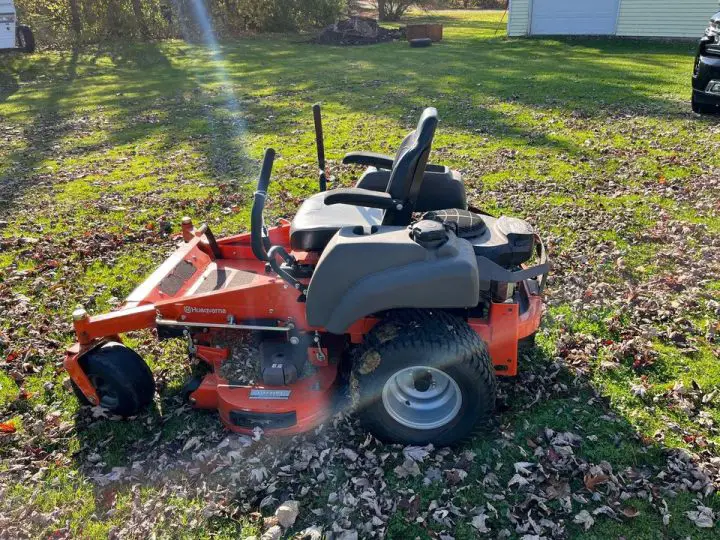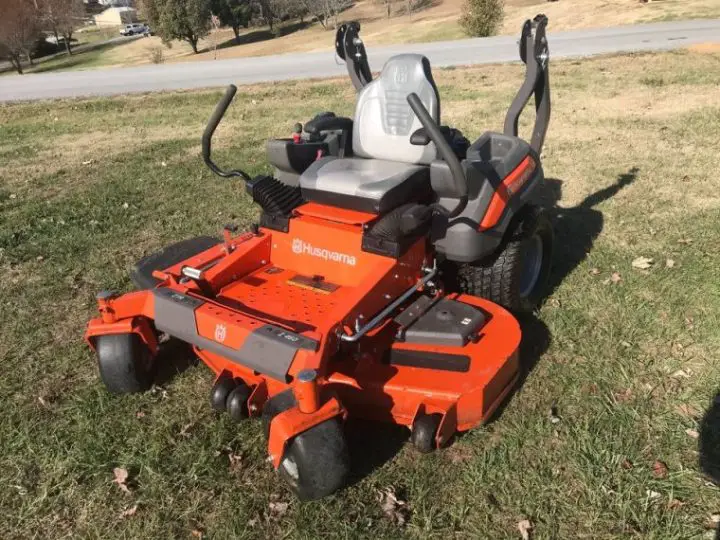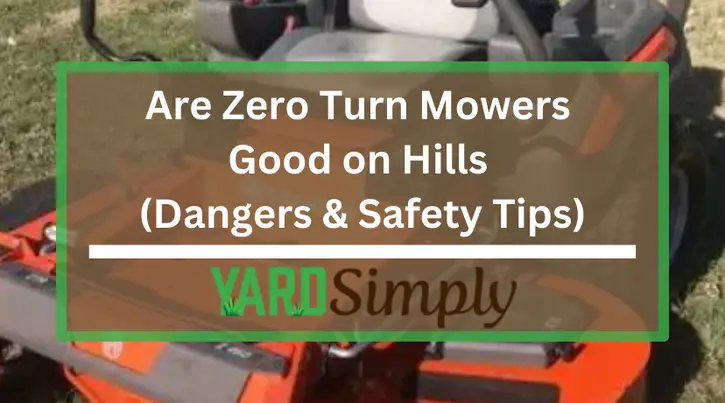Navigating hilly terrain with a zero turn mower can be challenging and requires an understanding of the equipment’s capabilities and limitations.
As a seasoned landscaper with extensive experience on varied properties, I’ve rigorously tested zero turn mowers on slopes.
My hands-on knowledge ensures you’re getting expert advice without unnecessary embellishments.
In this article, ‘Are Zero Turn Mowers Good on Hills,’ I’ll dissect the critical elements—such as center of gravity, tire design, and user skill—that impact a zero turn mower’s performance on hills.
Trust in the insights provided here, and read on to make informed decisions about maintaining your sloped lawn safely and efficiently.
Quick Summary
- Zero turn mowers can effectively navigate hills with careful operation, focusing on aspects like speed control, dry conditions, and cautious turning.
- Essential strategies include mowing side to side, starting at the bottom of the hill, and turning uphill to maintain control and stability.
- Manufacturer guidelines generally recommend using zero turn mowers on slopes up to 15 degrees to ensure safety and prevent tipping.
- Personally, I find that while zero turn mowers require cautious handling on slopes, they offer unparalleled efficiency and maneuverability on less steep inclines.
Are Zero Turn Mowers Good on Hills?
Zero turn mowers are not ideally suited for steep hills due to stability and traction concerns, but they can handle mild to moderate slopes effectively, typically up to 15 degrees.
How to Mow On Hills with Zero Turn
Navigating hills with a zero turn mower can be tricky, but I’ve got some tips that make it safer and more efficient.
- I always take it slow to maintain control, especially on slopes.
- I wait for the grass to dry before I start mowing.
Good tires and careful turning are crucial to prevent slipping and to ensure a clean cut.
Go Slowly
When mowing on hills with a zero turn mower, it’s crucial to take it slow to maintain control and ensure safety.
I’ve learned that haste can lead to mistakes, and on a slope, those mistakes could be dangerous. I always adjust my speed to the steepness of the hill and the conditions of the ground.
Wet grass, for example, requires extra caution as it can be slippery.
I also make sure I’m not making sudden turns or maneuvers that could cause the mower to tip or slide. It’s all about smooth, steady movements. By going slowly, I give myself time to react if the mower starts to slip or if I encounter an unexpected obstacle.
Safety’s always the top priority when I’m tackling those hills.
Mow in Dry Conditions
In addition to pacing myself on hills, I ensure the grass is dry before mowing with my zero-turn mower, as this reduces the risk of slipping and improves the machine’s grip on the terrain.
Wet grass can be like a slip ‘n slide for mowers, especially on slopes. If I mow after a rainstorm or early in the morning when dew is heavy, I’m asking for trouble. The tires can lose traction, which makes steering unpredictable and potentially dangerous.
I always check the weather forecast before planning my mowing day to avoid these risks. By waiting for the grass to dry, I’m not only making the task safer but also achieving a cleaner cut.
Damp blades tend to clump together, leading to an uneven trim. Dry conditions ensure a crisp, even finish every time.
Turn Cautiously
Mastering the art of cautious turning is crucial when mowing on hills with a zero turn mower. Sharp maneuvers can lead to loss of control and potential tip-overs.
I’ve learned to approach turns with a healthy respect for the mower’s speed and the hill’s gradient.
Gentle, wide arcs are my friends here, rather than quick, tight pivots. I make sure to slow down before initiating a turn, ensuring my wheels maintain traction and the mower stays stable.
It’s a dance of sorts, balancing the mower’s agility with the need for safety.
I’m always mindful that the lower side of the hill poses the greatest risk, so I adjust my turning radius accordingly. With each pass, I become more adept at navigating the terrain, always putting safety first.
Use Good Tires

While turning cautiously is essential for maintaining control on slopes, ensuring your zero turn mower is equipped with high-quality tires will significantly improve traction and stability on hilly terrain.
I’ve learned that tires with deeper treads offer better grip, which is crucial when navigating inclines to prevent slipping.
It’s not just about the tread though; the overall quality of the tire affects how well it holds up against the challenges of mowing on an angle.
I always make sure that my tires are properly inflated before tackling any hills. Under-inflated tires can cause a loss of traction, whereas over-inflated ones might make the ride uncomfortably bouncy and less stable.
Investing in the right tires has definitely made mowing on hills a safer and more efficient task for me.
How to Use a Zero Turn Mower on a Hill Safely

Navigating hills with a zero turn mower can be tricky, but I’ve got some tactics to ensure it’s done safely.
I’ll mow side to side, keeping the front end slightly uphill to maintain stability.
Starting at the bottom, I’ll work my way up, turning uphill at the end of each pass to prevent losing traction.
Related: Best Zero Turn Mower for Rough Terrain
1. Mow Side to Side
When mowing on a slope with a zero turn mower, it’s safest to cut grass by moving side to side rather than up and down the hill.
This approach reduces the risk of tipping or losing control, which can happen if the mower travels in a straight line up or down a steep incline.
I always ensure I’m comfortable with the mower’s operations and the hill’s gradient before starting. I take it slow, keeping my movements steady and deliberate to maintain traction.
It’s also crucial that I avoid making sudden turns or speed changes which could destabilize the mower.
2. Keep the Front End Slightly Uphill
Having established the side-to-side technique for mowing on slopes, it’s also essential to keep the mower’s front end slightly uphill to enhance stability and prevent tipping.
I’ve found that this position helps maintain better control over the machine, especially when navigating steeper grades. It’s about keeping a balance that doesn’t compromise the safety or effectiveness of the mow.
When I’m on a hill, I make sure to adjust my seating and handle the controls with care, so the mower’s weight stays distributed in a way that favors an uphill tilt.
This isn’t just about leaning forward; it’s about maneuvering the entire machine with a mindful approach to the slope’s angle. It’s a subtle move, but it makes a significant difference in reducing the risk of a rollover.
3. Start at the Bottom of the Hill
To ensure a safe start when mowing on hills with a zero turn mower, I always begin at the bottom and work my way upward. This method gives me the advantage of having gravity on my side, making it easier to control the machine.
As I ascend, I’m cautious, always aware that zero turn mowers can be less stable on inclines. I make sure my movements are smooth and deliberate to prevent tipping or losing control.
I also avoid making sharp turns or sudden changes in speed, as these actions can be risky on a slope.
Starting at the bottom allows me to gradually adjust to the hill’s gradient, ensuring I maintain a steady pace and keep the mower balanced throughout the task.
4. Turn Uphill at the End of Each Pass
After mastering the ascent by starting at the bottom of the hill, it’s crucial to focus on how to turn the mower at the end of each pass to safely navigate the terrain.
I make sure to approach the turn with caution, reducing my speed as I reach the end of my mowing path.
It’s best to turn the mower uphill rather than downhill to prevent tipping or sliding. I gently push the handles forward or pull them back to steer the mower in a smooth, controlled arc, always keeping the uphill wheel engaged to maintain traction.
If I feel the mower start to slip, I don’t panic. Instead, I calmly steer it back onto a straight path and slow down to regain control before attempting another turn.
5. If You Lose Traction, Don’t Stay in a Skid
When mowing on hills with a zero turn mower, it’s critical that I don’t let the mower continue in a skid.
If I start to lose traction, I need to act swiftly to regain control. I’ll gently ease off the machine’s throttle and carefully adjust the steering levers to steer the mower away from the skid, not into it.
Overcorrecting can make things worse, so it’s important to handle it like a car on ice. If the slope is too steep and I’m struggling for grip, I’ll head straight down the slope slowly, using the mower’s weight to stabilize my descent.
It’s better to lose a bit of time than risk a dangerous tumble. Safety always comes first.
When You Shouldn’t Use a Zero Turn Mower On Hills

I’ve found that not all hills are suitable for zero turn mowers, especially when it comes to very steep slopes. If the grass is wet, it’s a clear sign that I should park the mower and wait for drier conditions.
It’s just not worth the risk to myself or my lawn to tackle these challenging situations with a zero turn.
Very Steep Slopes
Navigating a zero turn mower on hills with very steep slopes can be dangerous and is generally discouraged due to the risk of tipping or losing control.
Zero turn mowers aren’t designed for such extreme angles, and the center of gravity can become compromised. If I can’t walk up the hill comfortably, I probably shouldn’t mow it with a zero turn.
I’ve learned that when the incline gets steeper than 15 degrees, it’s time to reconsider my approach. I’m aware that manufacturer guidelines usually cap safe operating slopes at 10 to 15 degrees.
Anything beyond that, I’m risking my safety. It’s crucial to respect these limitations and opt for alternative mowing methods or equipment to tackle very steep terrain.
Wet Grass
While steep slopes already pose a significant risk, adding wet grass into the mix makes using a zero turn mower on hills even more hazardous.
I’ve learned that when grass is wet, the mower’s wheels lose traction far more easily, increasing the likelihood of slipping or losing control.
The clippings themselves become a slippery mess that can clog the mower deck, potentially causing damage to the machine or interrupting my work with constant stoppages to clean it out.
I absolutely avoid mowing hills with my zero turn when the grass is damp. It’s just not worth the risk to my safety or the health of the lawn. Wet conditions can also lead to uneven cuts and compact the soil, which isn’t ideal for the grass’s growth.
Tips from the Experts
Deck Adjustability for Hills
Zero turn mowers with adjustable decks offer a significant advantage when it comes to mowing on hills. The ability to change the deck’s height is crucial for tackling different slopes effectively.
When going uphill, raising the deck helps avoid scalping the lawn, and lowering it while descending ensures a more uniform cut.
Mowers with a wide range of height settings are particularly beneficial as they allow for more precise adjustments tailored to the specific incline of the hill.
Hydraulic System Management
Proper management of the hydraulic system in zero turn mowers is essential, especially when operating on hilly terrain. Avoid pushing the hydraulics to their maximum when climbing hills, as this can reduce the lifespan of the pumps.
It’s advisable to maintain the hydro speed while allowing the engine to generate sufficient horsepower. This balance helps in creating the necessary pump pressure that aids in climbing hills more effectively.
Keeping the throttle between 3/4 to full also ensures that the hydraulic oil moves quickly, maintaining increased pump pressures which is beneficial both for the hydraulics and the engine, especially on hot days.
Read More: How to Change Hydraulic Fluid in Zero Turn
Walk-Behind Mowers for Steep Hills
For hills that are steeper than what a zero turn mower can safely handle (typically more than 15 degrees), consider using a commercial walk-behind mower. These mowers often provide better traction and safety on steep inclines.
While using any type of mower on a hillside, caution is necessary to prevent accidents. Walk-behind mowers are especially useful for larger hillside areas where a weed whip might not be efficient or practical.
Tire Types and Pressure for Hills
The type of tires and their pressure play a critical role in ensuring stability and traction when using a zero-turn mower on hilly terrain. Turf tires or those with a square edge are recommended for better grip on slopes.
Adjusting the tire pressure can also aid in enhancing the mower’s hold on the slope. A lower tire pressure, around 10 to 12 psi, is often effective for mowing on gradual hills, as it increases the tire surface area in contact with the grass.
This adjustment can prevent the tires from spinning or sliding downhill, especially in wet conditions.
Our Verdict
In my experience, handling zero turn mowers on hilly terrain has been a journey of learning and adaptation.
From the cautious approach of mowing side to side, to ensuring the grass is bone-dry before I even start the engine, each step has been about finding that sweet spot between efficiency and safety.
It’s a bit like a dance – knowing when to slow down, turn gently, and always keeping an eye on the tires and their grip on the ground.
I’ve come to realize that while zero turn mowers have their limits on steep slopes, with the right techniques and a bit of patience, they can be quite adept at managing less severe inclines.
My key takeaway? It’s not just about the machine, but also about how you use it.
Understanding its capabilities and respecting its limitations is what makes the difference between a well-maintained lawn and a risky mowing adventure.
Remember, safety always comes first – if the hill seems too steep or the grass too wet, it’s better to wait it out or choose a different mower. This approach has not only kept me safe but also ensured my lawns are always looking their best.
Frequently Asked Questions
Can zero turn mowers be equipped with special tires or weights for better hill performance?
Yes, I can equip zero turn mowers with special tires and weights to enhance their performance on slopes, which helps to improve traction and stability when I’m mowing on uneven terrain.
Are there any specific maintenance routines recommended for zero turn mowers after using them on hilly terrain?
After mowing on uneven ground, I always check my mower’s tire pressure and clean the deck. I also inspect the blades and belts for wear, ensuring they’re in top condition for the next use.
How does the performance of a zero turn mower on hills compare to traditional lawn tractors or rear-engine riding mowers?
I’ve found that zero turn mowers can struggle on steep slopes compared to traditional lawn tractors, which generally offer better traction and stability on hills due to their weight distribution and drivetrain design.
Can attachments like mulching kits or baggers affect the stability and safety of zero turn mowers on slopes?
I’ve noticed that adding mulching kits or baggers can impact the balance of my mower, potentially making it less stable on slopes. Safety can indeed be affected by these attachments.
Are there environmental conditions, such as wet grass or loose soil, where even a zero turn mower with good hill capabilities should not be used?
I’d avoid using my mower on wet grass or loose soil; these conditions can compromise traction and safety, making even a capable mower unsuitable for such challenging terrain.


